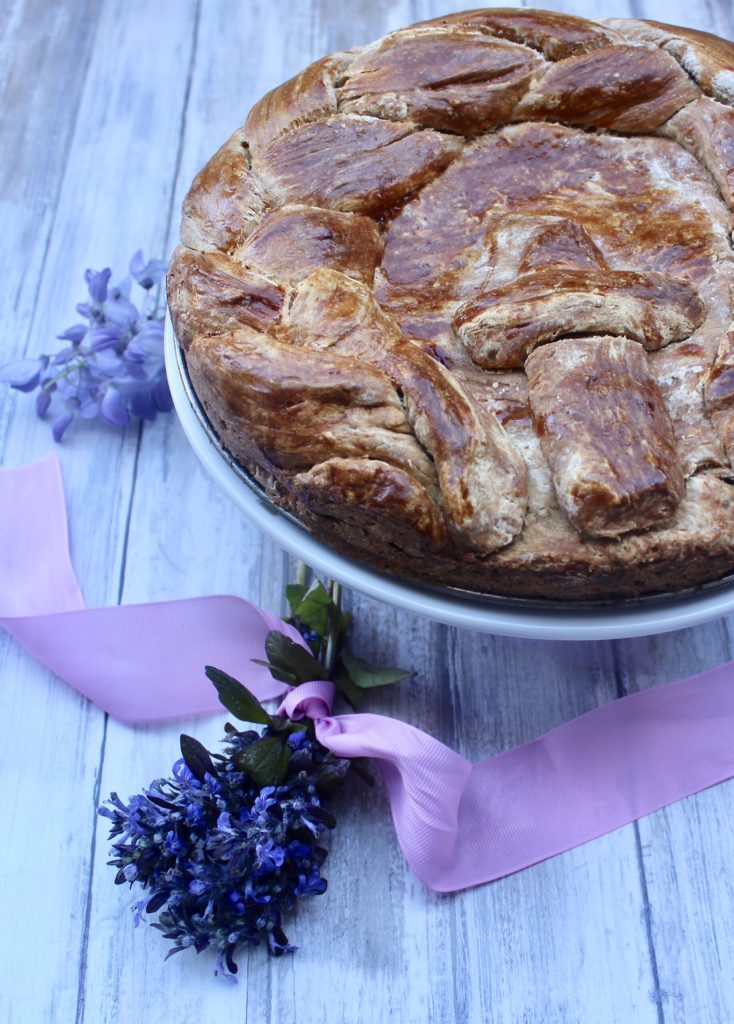The Paska is a cake of the Orthodox tradition, coming to Slavic lands with Christianity, from Greece.
The version I made, simple, with milk, butter, flour, sugar, yeast, and eggs is the one of the Greeks, Russians (who call it Kulich), Ukrainians, and Belarusians.
And it brings it closer to a sweet bread, rather than a panettone.
Do not confuse it with paskha (pascha or pasha) an Orthodox (and Finnish) Easter sweet made with tvorog, smetana (sour cream), raisins, almonds, vanilla, spices, and candied fruit.
To represent the Calvary of Jesus, the top is usually decorated with a cross and a braid (the crown of thorns on Jesus’ head).
❤In the spirit of culinary union that is characterizing the historical period we are going through, my desire is to associate the па́ска (paska) with Ukraine, where it is one of the elements of the traditional Easter basket, along with eggs, sausage, butter, and salt, and where it is accompanied by a sauce (hrudka or syrek) made of eggs, milk, and beet mixed with horseradish.
Paska was also the protagonist of the ViaggiandoMangiando on-air appointment on April 14, 2022, dedicated to Easter.
Find the live video HERE.

- Difficulty: Easy
- Cost: Economical
- Rest time: 3 Hours
- Preparation time: 10 Minutes
- Portions: 8 people
- Cooking methods: Oven
- Cuisine: Ukrainian
- Seasonality: All seasons
Ingredients
- 2.2 lbs flour
- 2 packets baking powder
- 5 tbsp sugar
- 1 1/2 cup milk
- 7.1 oz butter
- 3 eggs
- 1 egg yolk
- 1 pinch salt
- 1 packet vanillin (or vanilla bean)
Tools
- 1 Bakeware springform pan
Steps
Warm 1/2 cup of milk and dissolve 1 teaspoon of sugar in it, then sprinkle the yeast.
Let it rest and activate for 5-10 minutes, or until the yeast foams.
Meanwhile, oil a bowl where you will let the dough rise.
Whisk together flour, salt, and remaining sugar in a large bowl or the bowl of a stand mixer.
Then add the yeast mixture, eggs, softened butter, remaining milk, and vanilla.
Mix to combine the ingredients.
The dough will be moist and sticky.
Knead in the mixer or bowl for 4-5 minutes.
Form a ball with the dough and place it in the oiled bowl.
Cover with a damp cloth and let rise in a warm place for an hour to 90 minutes.
Deflate the dough and transfer it to a lightly floured surface.
Divide the dough in half.
Shape one half into a disk and put it at the bottom of a pan.
Divide the remaining dough into 4 pieces: 1 piece for the cross and 3 pieces for the braid.
For the braid: create 3 ropes. Braid them and arrange over the outer edges of the dough in the pan.
The cross: separate into two pieces, one slightly longer than the other, and create a cross pattern placing it in the center of the dough.
Cover and let rise until almost doubled.
Meanwhile, preheat the oven to 350°F.
Brush with a beaten egg before baking.
Then bake for 40-50 minutes, or until the bread is golden and well-cooked.
Remove from oven and let rest for 10 minutes.
And remove from the pan, place on a rack to cool completely.

Affiliate Link #adv
The Orthodox religion explained in a book:
Kulich, paskha, paska:
Kulich (meaning bread) and paskha (meaning pyramid-shaped ricotta cake) are Russian terms
In Ukraine the Easter cake is paska and the ricotta cake is sirna paska, while in Russia, Kulich or Kulič is the Easter bread.
The word kulich simply does not exist in the Ukrainian language.
The phrase “Easter cakes” is exclusive to Russians.

